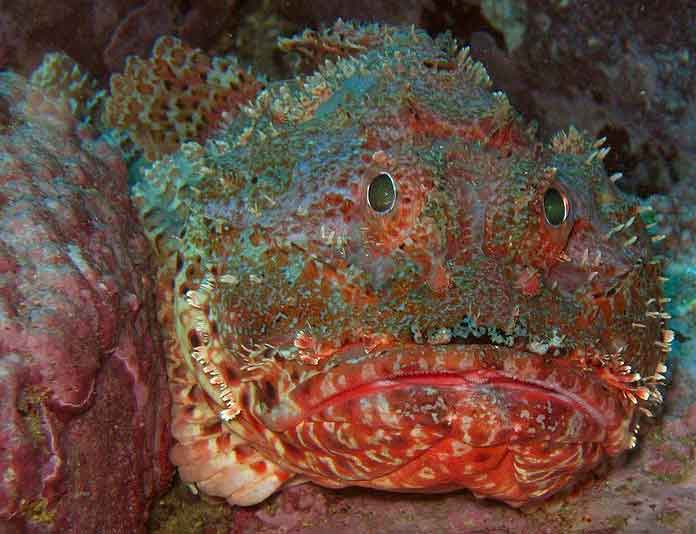Scorpaena cardinalis, The Gap, Sydney, NSW (*)
The grandfather hapuku, New Zealand scorpionfish, or New Zealand red rock cod, Scorpaena cardinalis, is a scorpionfish of the genus Scorpaena, found in southern Australia and all around New Zealand from shallow depths to 100 m. Their length is between 25 and 60 cm. The grandfather hapuku is a large-bodied spiny fish with a large head tapering to the tail. The head and the wide gill covers are set with bony ridges, solid sharp spines, and leafy skin appendages. The head is dominated by a huge, wide mouth with many rows of small abrasive teeth on all the jaw and mouth bones. When swallowing large prey the mouth and throat can be greatly extended. All the fins are large, the high solid-spined dorsal fin forming a crest when raised. These fish spend most of their time on the bottom, perched on the thick rays of their pectoral and anal fins, inside caves and crevices, waiting for prey to approach before making a lightning attack. Mostly red in colour with three darker red-brown bands on the back and an irregular mottling of lighter and darker red patches on the body and fins. This patterning provides almost perfect camouflage against similarly coloured rock encrustations. Reproduction is unusual in that the grandfather hapuku is viviparous and fertilization of the eggs and development of the young takes place internally. Females give birth to a few well developed larval fishes that spend a short time in the plankton before settling to the bottom as minute versions of the adult. They are easily caught by anglers over deep rocky reefs. When being raised the huge mouth opens acting as a sea anchor, slowing the process. Most are returned to the sea, but the flesh is actually delicious. Care must be taken to avoid the venomous spines during cleaning as they can inflict a painful wound. It is not unknown for divers to be bitten by larger specimens which can become aggressive. References
Retrieved from "http://en.wikipedia.org/" |
|

